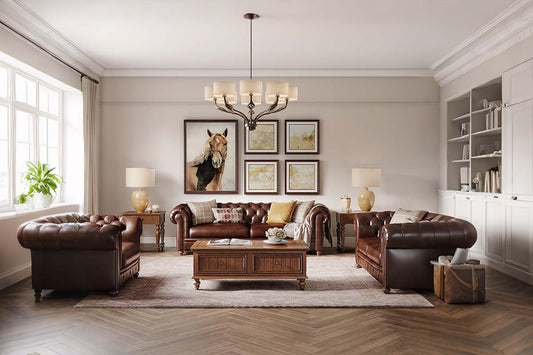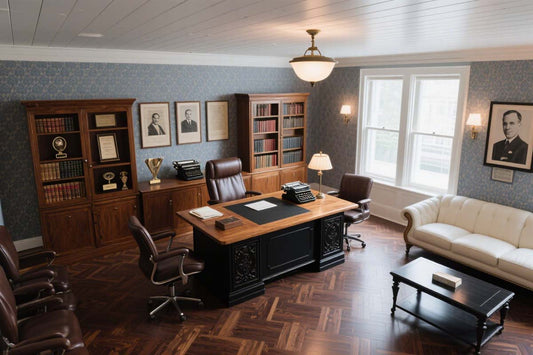
Top 10 Global Office Furniture Brands Leading the Workplace Evolution in 2025
Share
The future of the office is being shaped not just by technology—but by the furniture that supports people every day. In 2025, the world’s leading office furniture brands are not just makers of desks and chairs—they’re architects of workplace culture, well-being, and performance.
Here are 10 industry-defining brands that are transforming offices around the globe.
1. Herman Miller – The Pioneer of Ergonomic Design
Founded: 1905 | HQ: Michigan, USA | Key Products: Aeron, Embody, Sayl
Herman Miller revolutionized seating with the iconic Aeron Chair and continues to lead in ergonomics and sustainable design. Its products merge high-performance support with sleek aesthetics, making it a top choice for tech offices and executive suites alike.
2. Steelcase – The System Thinker
Founded: 1912 | HQ: Michigan, USA | Key Products: Gesture, Leap, Answer systems
Steelcase goes beyond chairs and desks—it designs entire ecosystems. Known for research-backed workspace systems and collaboration zones, Steelcase remains a top global player, especially in corporate and government sectors.
3. MillerKnoll – The Designer Collective
Formed: 2021 (Herman Miller + Knoll) | HQ: USA
This design powerhouse combines mid-century icons like the Eames lounge with contemporary pieces for modern workplaces. MillerKnoll embodies both legacy and innovation, bringing timeless elegance into ergonomic office design.
4. Haworth – Global, Flexible, Sustainable
Founded: 1948 | HQ: Michigan, USA | Key Products: Fern, Zody, Compose
Haworth is known for blending global design aesthetics with modular office systems. Their “Zero Waste to Landfill” commitment and cultural sensitivity in local markets make them a favorite in Europe and Asia.
5. Vitra – Where Furniture Meets Art
Founded: 1950 | HQ: Switzerland | Key Products: ID Chair, Aluminium Chair
Vitra collaborates with design legends to create workplace masterpieces. From bold lounge pieces to smart desk chairs, Vitra designs reflect architectural sophistication and museum-worthy aesthetics.
6. Humanscale– Minimalism with Maximum Support
Founded: 1983 | HQ: New York, USA | Key Products: Freedom, Diffrient, Float desk
Humanscale distills form and function into minimal designs that adapt intuitively to users. Their award-winning seating is widely used in creative and tech sectors for its adjustability and durability.
7. Okamura – Japanese Precision for the Office
Founded: 1945 | HQ: Yokohama, Japan | Key Products: Contessa II, Sabrina
Okamura blends precision engineering with quiet comfort. Especially popular in Asia-Pacific markets, the Contessa II is often hailed as “the Aeron of the East” for its refined mechanics and aesthetic.
8. Kinnarps – The Nordic Green Innovator
Founded: 1942 | HQ: Sweden | Key Products: Capella, Esencia
Kinnarps leads in European sustainability standards. All products are manufactured in Sweden using eco-certified materials. Their furniture pairs minimalist Scandinavian design with ergonomic functionality.
9. HNI Corporation (HON) – The Workhorse Brand
Founded: 1944 | HQ: Iowa, USA | Key Products: Ignition, Solve, 10500 Series
HON specializes in cost-effective, durable office furniture for small-to-medium businesses and institutional clients. With short lead times and broad distribution, they’re a dependable choice for outfitting large teams.
10. Global Furniture Group – Utility Meets Affordability
Founded: 1966 | HQ: Canada | Key Products: Loover, Princeton, Bridges
Global excels at delivering reliable, modular furniture for hospitals, universities, and public agencies. Their broad catalog and budget-conscious design make them a leader in public sector workspace solutions.
Comparison Table
| Brand | Founded | Specialty | Key Market |
|---|---|---|---|
| Herman Miller | 1905 | Ergonomic chairs | North America, Global |
| Steelcase | 1912 | Workspace systems | Global enterprises |
| MillerKnoll | 2021 (merged) | Designer furniture | Creative offices |
| Haworth | 1948 | Sustainable systems | Europe, Asia |
| Vitra | 1950 | Artistic design | High-end offices |
| Humanscale | 1983 | Minimalist ergonomics | Tech, Startups |
| Okamura | 1945 | Precision engineering | APAC, Government |
| Kinnarps | 1942 | Eco Scandinavian | EU Markets |
| HNI (HON) | 1944 | Budget + Volume | Education, SMEs |
| Global Furniture Group | 1966 | Public sector | Canada, US |
A New Contender from the world: Meet POVIMO
While global giants have long shaped the modern workplace, a new generation of brands is rising—combining refined craftsmanship, premium materials, and a deep understanding of what today’s professionals truly need.
Among them, POVIMO stands out as a quiet force redefining executive seating.
Handcrafted with genuine full-grain leather and built on a whisper-quiet mobility system, POVIMO’s office chairs offer more than visual prestige—they deliver orthopedic-grade back support, breathable luxury, and seamless adaptability across home and corporate settings.
For professionals who expect more from their chairs—and from themselves—POVIMO offers an experience that’s as elegant as it is enduring.
Conclusion: A Chair Is More Than a Seat
The office furniture brands of 2025 are designing more than just furniture—they're shaping how we think, move, and perform at work. Whether you’re planning a corporate HQ or a home office upgrade, these 10 global leaders offer design excellence backed by decades of innovation and research.
Frequently Asked Questions
1. How should I choose between these top 10 brands?
It depends on your priorities.
– If ergonomics and medical-grade support are essential, brands like Herman Miller, Steelcase, and Humanscale are industry leaders.
– For those seeking high design and aesthetics, Vitra and MillerKnoll bring museum-level creativity into office settings.
– If you're focused on sustainability and local manufacturing, look at Haworth or Kinnarps.
– For budget-conscious or large-scale procurement, HON and Global Furniture Group are efficient and reliable.
2. Why is ergonomic design so important in 2025?
As hybrid work becomes the norm and screen time increases, poor seating leads to chronic back pain, neck strain, and reduced focus. Ergonomic chairs adapt to your body, promoting healthy posture and long-term comfort, which improves productivity and reduces health-related absences.
3. Are premium chairs worth the higher price tag?
Yes—especially over time. High-end chairs may cost more upfront but offer:
- Better posture support
- Longer lifespan (5–15 years)
- Lower risk of injury and discomfort
- Higher productivity and perceived professionalism
4. What should I look for in an executive chair in particular?
Key features to evaluate:
- Genuine leather or breathable materials
- High-density seat foam with lumbar support
- Silent, multi-surface casters
- Recline and tilt mechanisms
- Sturdy base (steel or aluminum alloy)
5. Which brand is best for home offices?
If your home office doubles as a formal or creative space, consider:
- Humanscale or Steelcase for minimalist ergonomics
- Vitra or MillerKnoll for designer aesthetics
- POVIMO if you want a luxurious leather executive chair that feels equally at home in a corporate or residential setting
6. What global trend is shaping office furniture most in 2025?
Three key trends:
- Hybrid flexibility: Furniture must adapt to different environments, including home offices and co-working spaces.
- Sustainability: Recycled materials, modular builds, and carbon-neutral supply chains are in demand.
- Status + comfort fusion: Professionals increasingly seek chairs that reflect authority and offer therapeutic support.




